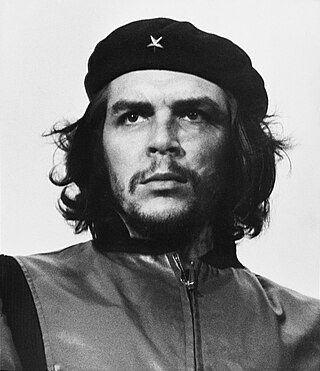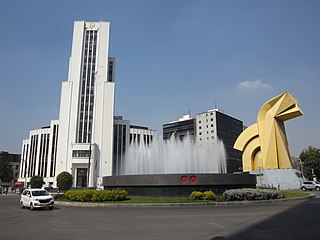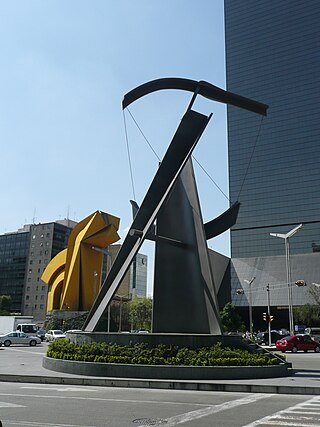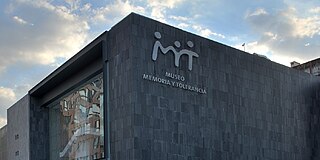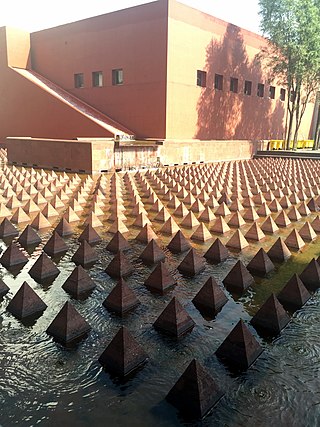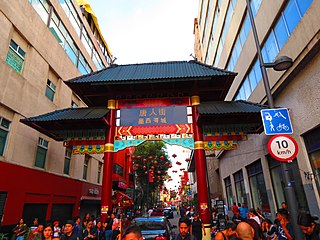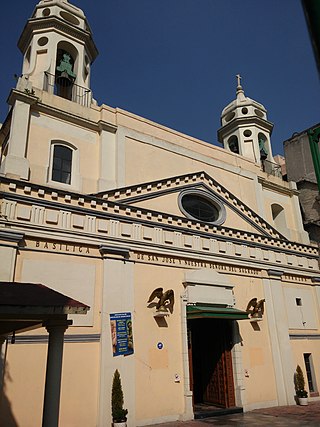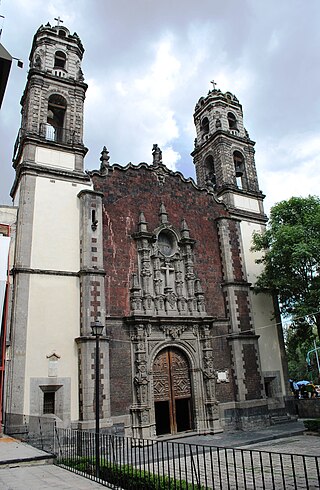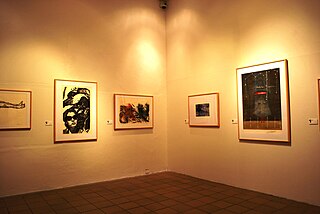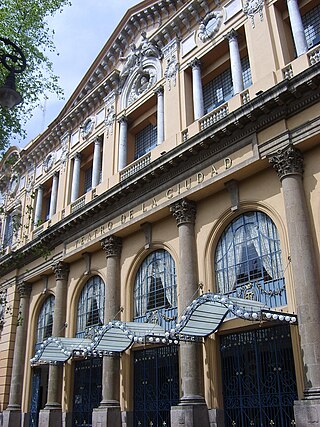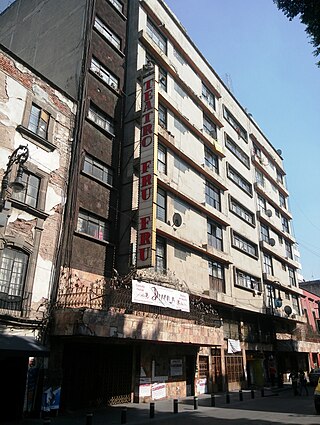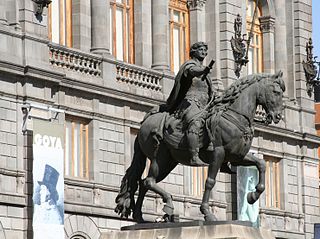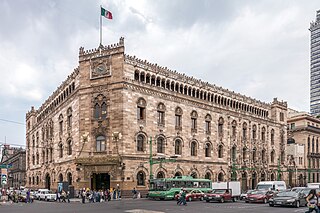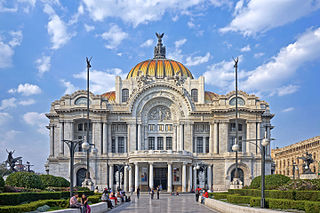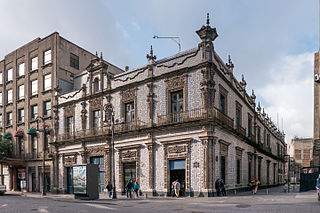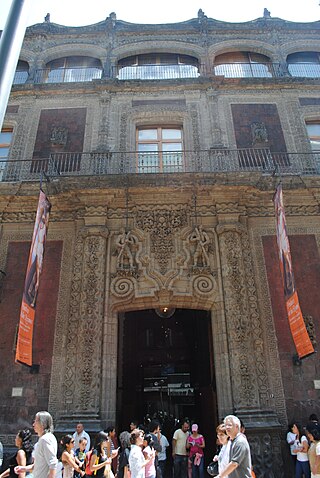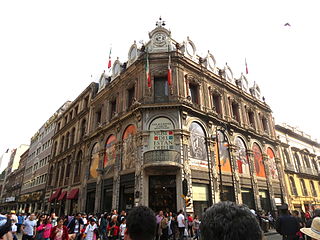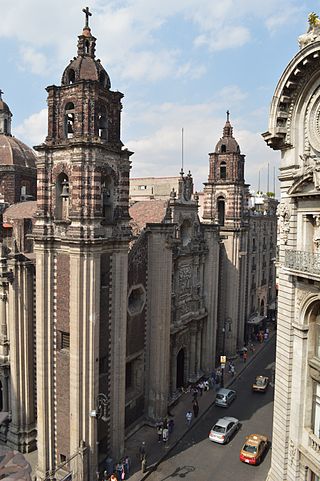Self-guided Sightseeing Tour #3 in Mexico City, Mexico
Legend
Guided Free Walking Tours
Book free guided walking tours in Mexico City.
Guided Sightseeing Tours
Book guided sightseeing tours and activities in Mexico City.
Tour Facts
7.7 km
133 m
Experience Mexico City in Mexico in a whole new way with our free self-guided sightseeing tour. This site not only offers you practical information and insider tips, but also a rich variety of activities and sights you shouldn't miss. Whether you love art and culture, want to explore historical sites or simply want to experience the vibrant atmosphere of a lively city - you'll find everything you need for your personal adventure here.
Activities in Mexico CityIndividual Sights in Mexico CitySight 1: Templo de San Fernando
The Temple of San Fernando is a Catholic temple located in the Guerrero neighborhood, next to the cemetery of the same name. He was part of the Apostolic College of Propaganda Fide of San Fernando of the Franciscan Order, where the missionaries who participated in the evangelization of New Spain were trained.
Sight 2: Ché Guevara y Fidel Castro
Ernesto "Che" Guevara was an Argentine Marxist revolutionary, physician, author, guerrilla leader, diplomat, and military theorist. A major figure of the Cuban Revolution, his stylized visage has become a ubiquitous countercultural symbol of rebellion and global insignia in popular culture.
Sight 3: Fuente de la República
The Fuente de la República is a carbon steel fountain and sculpture installed in Mexico City, Mexico. It was inaugurated on 13 December 2007 by Marcelo Ebrard, the Federal District's head of government, and was placed at the intersection of Avenida Paseo de la Reforma, Avenida Juárez and Avenida Bucareli, in the Cuauhtémoc borough. The fountain was created specifically for the celebrations of the 200th anniversary of the country's independence in 2010. It was designed by Manuel Felguérez, who also designed the Puerta 1808 sculpture found in front of it.
Sight 4: Puerta 1808
Puerta 1808 is an outdoor carbon steel sculpture by Manuel Felguérez installed in Mexico City, Mexico. It was inaugurated on 20 October 2007 by Marcelo Ebrard, the head of government, and was placed in the corner of Paseo de la Reforma and Avenida Juárez, in Cuauhtémoc. It is a 15 meters high sculpture that lies on a 2 meters high plinth.
Sight 5: Plaza de la Solidaridad
The Plaza de la Solidaridad is a plaza located in Mexico City, Mexico, adjacent to the Alameda Central. During the sixteenth century, the area in which the park is now located was on the outskirts of the city. When the city grew and urbanized, the Convent of San Diego occupied the space.
Sight 6: Teatro Metropólitan
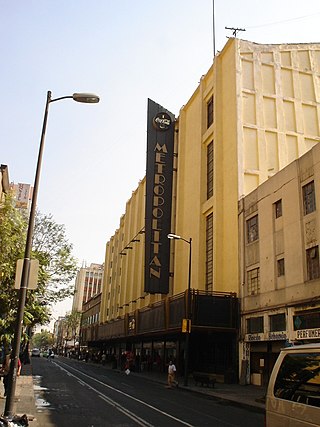
The Teatro Metropólitan is a theater in Mexico City. It was previously known as the Cine Metropólitan, and was built as a movie palace. The architect was Pedro Gorozpe E. with interior decorations by Aurelio G. Mendoza.
Sight 7: Museo Memoria y Tolerancia
The Museum of Memory and Tolerance is a museum in Mexico City. It opened its doors on October 18, 2010 and seeks to spread respect for diversity and tolerance based on historical memory through the use of genocide exhibitions and multimedia presentations of values in favor of tolerance.
Wikipedia: Museo Memoria y Tolerancia (México) (ES), Website
Sight 8: País de Volcanes
País de volcanes is an outdoor fountain and sculpture by the Spanish-born Mexican artist Vicente Rojo Almazán, installed outside Mexico City's Secretariat of Foreign Affairs Building and next to the Memory and Tolerance Museum, in Mexico. It is a 1,000 square meters (11,000 sq ft) artwork that features 1,034 ocher-colored pyramids standing out of the water; the artwork was made with tezontle, a type of reddish volcanic rock. The central body of the fountain contains water that flows subtly down its sides to the area with the pyramids. For Jaime Moreno Villarreal of Letras Libres, the fountain is located slightly below the square level so that the viewer can appreciate the volcanic geography.
Sight 9: Templo de Corpus Christi

The Corpus Christi Church is a former church on Avenida Juárez in the Historic center of Mexico City. It is the only remaining part of the Convent of Corpus Christi, founded in 1724 for indigenous women and which was closed as part of the Reform Laws. The architect of the baroque structure was Pedro de Arrieta who also designed the Palace of the Inquisition and the Church of San Felipe Neri "La Profesa".
Sight 10: Chinatown
Barrio Chino is a barrio located in the downtown area of Mexico City, near the Alameda Central and Palacio de Bellas Artes. Barrio Chino exists primarily on two blocks along Dolores Street and one block east and west of the street. There was an expulsion of the ethnic Chinese in the 1930s and since then the ethnic Chinese have mixed and dispersed with the local population. According to the government of Mexico City, about 3,000 families in the city have Chinese heritage. In many parts of the older sections of the city, there are “cafes de chinos”, which are eateries that serve Chinese and Mexican food. The buildings in Barrio Chino are no different from the rest of the city, but businesses here are either restaurants or importers. Most of the shops and restaurants here had abundant Chinese-style decorations and altars, but statues of the Virgin of Guadalupe and San Judas Tadeo can be seen as well.
Sight 11: Basílica de San José y Nuestra Señora del Sagrado Corazón
The Basilica of San José and Our Lady of the Sacred Heart is a Catholic temple located in the San Juan neighborhood of the Historic Center of Mexico City in the Cuauhtémoc Mayor's Office. It was built at the end of the eighteenth century and rebuilt in the middle of the nineteenth century. Its patron saint's day is celebrated on March 19. It is characterized by being one of the few colonial buildings that are preserved in the neighborhood of San Juan and for holding the title of minor basilica. It was declared a historical monument on February 9, 1931,
Wikipedia: Basílica de San José y Nuestra Señora del Sagrado Corazón (ES)
Sight 12: Santa Vera Cruz
The Santa Veracruz Monastery in the historic center of Mexico City is one of the oldest religious establishments in Mexico City and was the third most important church in the area in the 16th century. It was established by a religious brotherhood founded by Hernán Cortés.
Sight 13: Museo Nacional de la Estampa
The Museo de la Estampa is a museum in Mexico City, dedicated to the history, preservation and promotion of Mexican graphic arts. The word “estampa” means works in the various printmaking techniques which have the quality of being reproducible and include seals, woodcuts, lithography and others. The museum was created in 1986 and located in a 19th-century Neoclassical building located in the Plaza de Santa Veracruz in the historic center of the city. This building was remodeled both to house the museum and to conserve its original look.
Sight 14: Teatro Blanquita
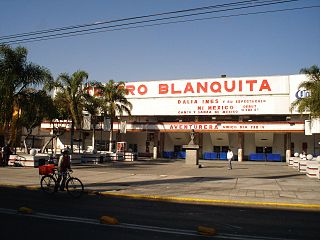
The Blanquita Theater, also called El Blanquita, was a theater in Mexico City inaugurated on August 27, 1960 and was located at number 16 of the Lázaro Cárdenas Central Axis at the height of the Historic Center of Mexico City. It was inaugurated at the initiative of the writer and theater entrepreneur Margo Su and her husband Félix Cervantes. On its stage, popular plays and concerts were presented. In 2010 it was one of the five most visited in the Mexican capital. Blanca Eva Cervantes was Félix Cervantes' first cousin.
Sight 15: Museo del Tequila y el Mezcal
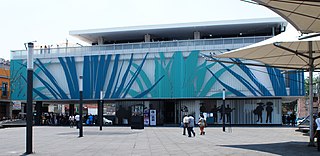
The Museum of Tequila and Mezcal is a cultural venue that exhibits the most representative of the culture of tequila and mezcal through exhibitions, conferences, concerts, gastronomy samples and other cultural manifestations located in Plaza Garibaldi in Mexico City.
Sight 16: Teatro de la Ciudad Esperanza Iris
The Teatro de la Ciudad was built as the Teatro Esperanza Iris in 1918 and is now one of Mexico City’s public venues for cultural events. The theater is located in the historic center of Mexico City on Donceles Street 36.
Sight 17: Teatro Fru-fru
The Teatro Fru (Fru Theater) is a theater in Mexico City. It was inaugurated on January 1, 1899 under the name Teatro Renacimiento. In 1973 it was re-inaugurated with its current name. It is located at number 24 in the Donceles Street, in the Centro Histórico de la Ciudad de México
Sight 18: El Caballito
The equestrian statue of Charles IV of Spain is a bronze sculpture cast by Manuel Tolsá built between 1796 and 1803 in Mexico City, Mexico in honour of King Charles IV of Spain, then the last ruler of the New Spain. This statue has been displayed in different points of the city and is considered one of the finest achievements of Mr. Tolsá. It now resides in Plaza Manuel Tolsá.
Sight 19: Palacio Postal
The Palacio de Correos de México, also known as the "Correo Mayor" is located in the historic center of Mexico City, on the Eje Central near the Palacio de Bellas Artes. It was built in 1907, when the Post Office became a separate government entity. Its design and construction was the most modern at the time, including a very eclectic style which mixed several different traditions, mainly Neo-Plateresque, into a very complex design. In the 1950s, the building was modified in a way that caused stress and damage, so when the 1985 earthquake struck Mexico City, it was heavily damaged. In the 1990s, restoration work has brought the building back to original construction and appearance.
Sight 20: Palacio de Bellas Artes
Get Ticket*The Palacio de Bellas Artes is a prominent cultural center in Mexico City. This hosts performing arts events, literature events and plastic arts galleries and exhibitions. "Bellas Artes" for short, has been called the "art cathedral of Mexico", and is located on the western side of the historic center of Mexico City which is close to the Alameda Central park.
Sight 21: Casa de los Azulejos
Get Ticket*The Casa de los Azulejos or Palacio de los Condes del Valle de Orizaba is an 18th-century Baroque palace in Mexico City, built by the Count of the Valle de Orizaba family. The building is distinguished by its facade, which is covered on three sides by blue and white colonial Talavera tiles from Puebla state. The palace remained in private hands until near the end of the 19th century. It changed hands several times before being bought by the Sanborns brothers who expanded their soda fountain/drugstore business into one of the best-recognized restaurant chains in Mexico. The house today serves as their flagship restaurant.
Sight 22: Iglesia de San Francisco
The Convent of San Francisco is located at the western end of Madero Street in the historic center of Mexico City, near the Torre Latinoamericana and is all that remains of the church and monastery complex. This complex was the headquarters of the first twelve Franciscan friars headed by Martín de Valencia who came to Mexico after receiving the first authorization from the Pope to evangelize in New Spain. In the early colonial period, this was one of the largest and most influential monasteries in Mexico City. It was built on the site of where Moctezuma II’s zoo once was. At its peak, the church and monastery covered the blocks now bordered by Bolivar, Madero, Eje Central and Venustiano Carranza Streets, for a total area of 32,224 square metres.
Wikipedia: Church of San Francisco, Madero Street, Mexico City (EN)
Sight 23: Templo Expiatorio de San Felipe de Jesús
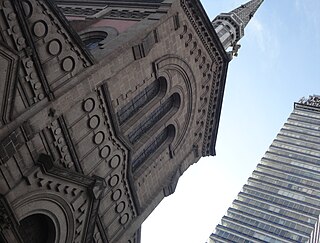
Templo Expiatorio Nacional de San Felipe de Jesús is an historic church in Mexico City, Mexico.
Wikipedia: Templo Expiatorio Nacional de San Felipe de Jesús (EN)
Sight 24: Palacio de Iturbide
The Palace of Iturbide is a large palatial residence located in the historic center of Mexico City at Madero Street #17. It was built by the Count of San Mateo Valparaíso as a wedding gift for his daughter. It gained the name “Palace of Iturbide” because Agustín de Iturbide lived there and accepted the crown of the First Mexican Empire at the palace after independence from Spain. Today, the restored building houses the Fomento Cultural Banamex; it has been renamed the Palacio de Cultura Banamex.
Sight 25: Museo del Estanquillo
The Museo del Estanquillo is located in the Historic Center of Mexico City, Mexico. The museum houses the personal collection of the writer Carlos Monsivais, encompassing paintings, photography, toys, albums, calendars, advertising and books.
Sight 26: Iglesia de la Profesa
The Church of San Felipe Neri, commonly known as "La Profesa", is a Roman Catholic parish church that was established by the Society of Jesus late in the 16th century as the church of a community of professed Jesuits. The church is considered to be an important transitional work between the more sober or moderate Baroque style of the 17th century and the extremely decorated manifestations of the Baroque of the 18th century in Mexico.
Sight 27: Constitution Square
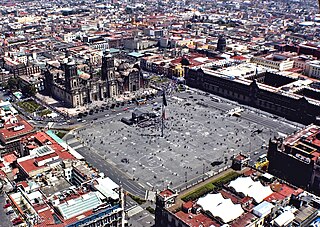
Zócalo is the common name of the main square in central Mexico City. Prior to the colonial period, it was the main ceremonial center in the Aztec city of Tenochtitlan. The plaza used to be known simply as the "Main Square" or "Arms Square", and today its formal name is Plaza de la Constitución. This name does not come from any of the Mexican constitutions that have governed the country but rather from the Cádiz Constitution, which was signed in Spain in the year 1812. Even so, it is almost always called the Zócalo today. Plans were made to erect a column as a monument to independence, but only the base, or zócalo, was built. The plinth was buried long ago, but the name has lived on. Many other Mexican towns and cities, such as Oaxaca, Mérida, and Guadalajara, have adopted the word zócalo to refer to their main plazas, but not all.
Share
How likely are you to recommend us?
Disclaimer Please be aware of your surroundings and do not enter private property. We are not liable for any damages that occur during the tours.
GPX-Download For navigation apps and GPS devices you can download the tour as a GPX file.

